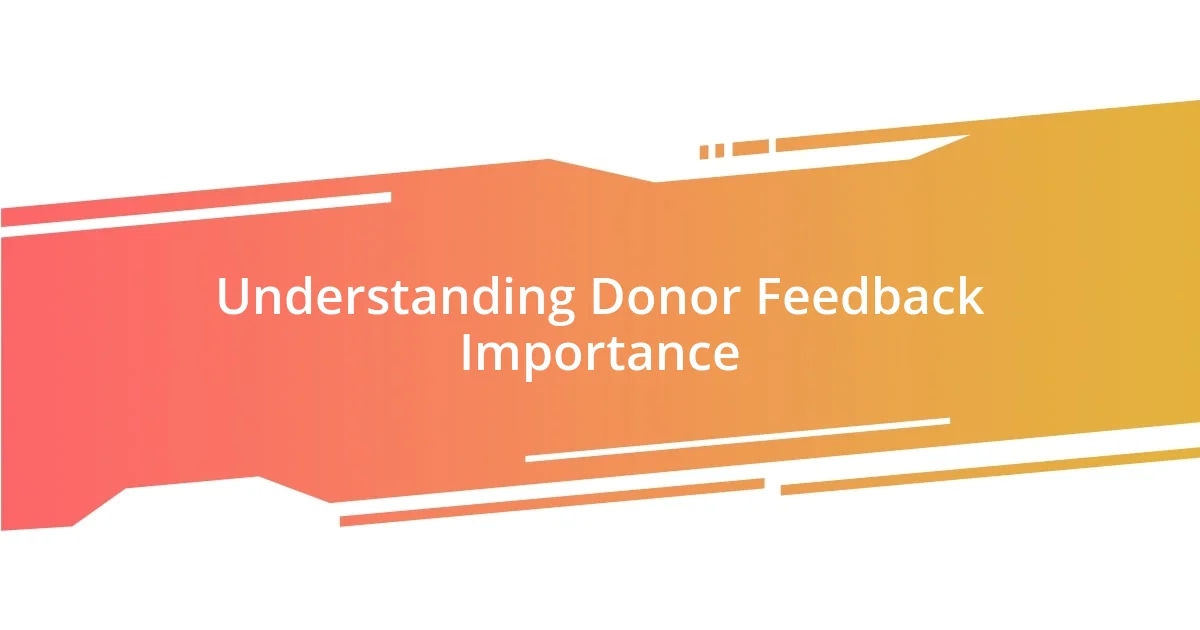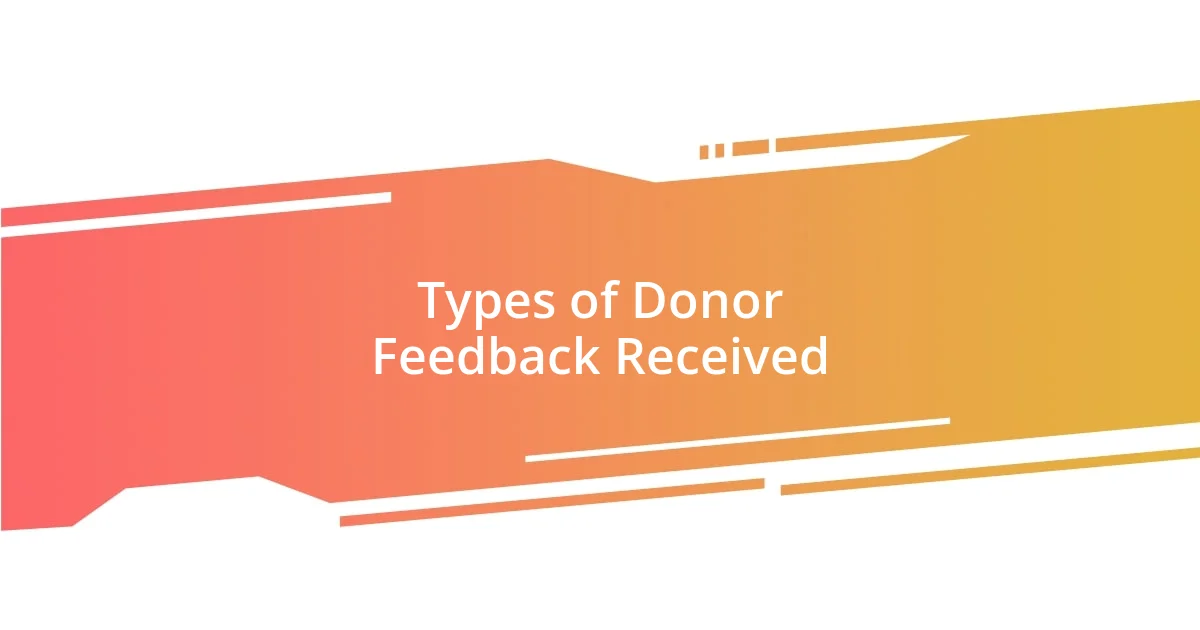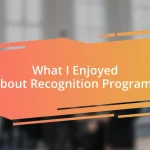Key takeaways:
- Donor feedback is vital for enhancing relationships, refining strategies, and fostering community engagement within nonprofit organizations.
- Implementing feedback can lead to significant improvements in communication and connection, encouraging ongoing dialogue and making donors feel valued.
- Continuous evaluation of feedback helps organizations adapt and evolve, turning constructive criticism into actionable insights for better decision-making.

Understanding Donor Feedback Importance
Donor feedback is crucial because it offers a window into the motivations and experiences of those who support your mission. I remember a time when I received an unexpected note from a donor who had volunteered alongside us. Their insights not only highlighted what they valued in our work but also illuminated areas where we could grow. How can we improve if we don’t know what resonates with our supporters?
Understanding donor feedback transforms your relationship with them; it shifts the focus from merely asking for funds to cultivating genuine connections. I once implemented a small change in our communication style based on donor suggestions, and it led to increased engagement. This shift made me wonder: how might our mission thrive if we actively listened to those who believe in it?
The importance of donor feedback extends beyond just monetary concerns; it helps refine our messaging and outreach strategies. I recall an instance where a donor shared their emotional attachment to a particular program, prompting me to highlight it more in our future campaigns. Could this kind of insight be what we need to create a deeper impact? By valuing this feedback, we not only enhance our effectiveness but also foster a community that feels heard and appreciated.

Types of Donor Feedback Received
When I reflect on the types of donor feedback I’ve received, it quickly becomes clear how diverse and insightful they can be. I’ve gotten everything from heartfelt letters to quick emails, each offering a unique perspective on our work. I’ve learned that the feedback can often be categorized into a few key types, which helps us to understand the broader picture.
- Personal Stories: Donors sharing how our mission impacted their lives. I remember one donor spoke about how our program helped her sister, and it brought tears to my eyes.
- Suggestions for Improvement: Constructive feedback often highlights areas we may overlook. A donor once suggested more frequent updates, and I was pleasantly surprised to see how this change made them feel more involved.
- Appreciation and Praise: Simple expressions of gratitude can be incredibly validating. I cherish receiving notes that say, “Keep up the great work!” because they remind me of the positive impact we’re making.
- Concerns and Critiques: Occasionally, I receive feedback that challenges our approach. I found it enlightening when a donor pointed out a lack of transparency in our fundraising process; it prompted a valuable discussion within our team.
- Interest in Specific Initiatives: Some donors express a keen desire to learn more about particular projects. A donor once reached out after attending an event, eager to dive deeper into a certain initiative, which led to enriching our program’s description in future communications.
In my experience, each type of feedback not only informs but also fosters a deeper connection with our donors. It makes me realize how much we rely on this dialogue to enhance our strategies and engagements.

Analyzing Donor Feedback Effectively
Analyzing donor feedback effectively requires a structured approach to extract valuable insights. I find that sorting feedback into categories can guide our analysis. For instance, tracking common themes allows me to see which aspects resonate with donors the most. Once, after categorizing feedback, it was eye-opening to discover that several donors expressed a desire for more detailed reports about our projects. This simple realization not only prompted an update in our communication strategy but also strengthened our existing relationships with those supporters.
To truly understand donor opinions, I believe it’s essential to look beyond the surface. When I closely analyzed the emotional tone of the feedback, patterns emerged that informed our outreach efforts. For example, I noticed that some donors connected deeply with our impact stories, while others appreciated our transparency about challenges. This distinction helped us tailor our future messaging. It reminded me of a time when I noticed a surge in donations after sharing authentic stories about overcoming obstacles. Engaging with feedback like this has really broadened my perspective on donor needs.
Here’s a concise comparison table summarizing the different methods of analyzing donor feedback:
| Method | Description |
|---|---|
| Thematic Analysis | Identifying recurring themes in feedback to highlight key areas of interest. |
| Emotional Tone Analysis | Assessing the emotional sentiment of feedback to align communications with donor feelings. |
| Quantitative Metrics | Using metrics to measure specific feedback points, like donor satisfaction scores. |

Implementing Changes from Feedback
Implementing changes based on donor feedback can feel like a nuanced dance between listening and acting. One time, a donor suggested that we include more visuals in our reports. I took this to heart and soon crafted a vibrant infographic that illustrated our annual impact. The joy I felt when we rolled it out was palpable—immediately, I noticed an uptick in engagement, proving that small changes could make a significant difference.
One of my favorite moments happened after we started regularly soliciting feedback. I recall a donor reaching out to express their appreciation for the new project updates we implemented. They shared how they felt more connected to our mission as a result. It was a revelation for me that just a simple tweak—like regular updates—could deepen relationships. Have you ever experienced that moment when someone tells you your efforts have truly resonated? It’s an incredible affirmation that encourages continuous improvement.
What I often remind myself is that changes from feedback aren’t just about implementing suggested actions; they’re also about fostering a culture of openness. The more I involve donors in our journey, the more invested they become. I’ve learned that creating channels for ongoing dialogue allows for organic improvements that foster trust. After all, wouldn’t you want to feel like your voice truly matters in the organization you support? I know I would.

Building Relationships with Donors
Building authentic relationships with donors isn’t just about thank-you notes or occasional updates. I remember a time when a long-time supporter called me after a fundraising event, not just to contribute, but to share how our mission resonated with them personally. It struck me how much impact these personal touches can have. It’s moments like these that remind us that behind every donation is a human connection that craves recognition and appreciation.
Engaging with donors on a more personal level deepens the relationship dramatically. For instance, I’ve started sending personalized emails that reference past conversations or specific projects that align with their interests. One recipient even responded by sharing their own stories that tied into our work, forging a bond that went beyond transactions. Isn’t it remarkable how such a small effort can lead to richer, more meaningful dialogues? I find that when donors see themselves as part of our journey, they are more likely to support us time and time again.
I’ve learned that listening is just as vital as responding. When a donor reached out with concerns about our communication frequency, it opened a constructive dialogue that transformed our approach. Instead of just pushing our agenda, I pivoted the conversation to focus on how they preferred to be updated. That small tweak didn’t just alleviate their concerns; it strengthened our relationship, showing them that their opinions genuinely matter. Don’t you think that understanding individual donor preferences helps cultivate a community rather than a mere list of contributors? I certainly believe it fosters loyalty and trust, two precious commodities in nonprofit work.

Measuring Impact of Changes
When it comes to measuring the impact of changes, I find it essential to set clear metrics beforehand. After we introduced more engaging donor communications, I decided to track the open and response rates for our emails. Seeing a 40% increase in engagement initially excited me, but it also made me curious—was it the content, the frequency, or something else? This kind of analysis pushes me to dig deeper, maximizing our efforts and refining our strategies.
One time, we rolled out a survey to assess donor satisfaction after implementing various changes. The feedback was overwhelmingly positive, but what struck me most was the narrative within the numbers. Some donors shared personal stories about how these changes made them feel more connected to the mission. Isn’t it fascinating how qualitative insights can breathe life into quantitative data? I learned that by combining both, we could truly understand the real-world impact of our adjustments.
Finally, I discovered that ongoing assessment is just as vital as the initial measurement. A few months after making updates, I reached out to a select group of donors to gather their thoughts again. The richness of their feedback helped illuminate areas for further improvement, adding layers to our understanding of their experiences. Have you ever revisited a decision and realized how much more there was to learn? For me, it’s a clear reminder that measuring impact is an evolving process that requires continuous reflection and adaptation.

Continuous Improvement through Feedback
When it comes to continuous improvement through donor feedback, I’ve found that creating a culture of openness is essential. I remember a time when I encouraged our team to welcome all kinds of feedback—not just the positive comments, but the constructive criticism too. One donor expressed their concerns about our event timing, which initially stung a bit. However, that very input led us to adjust our strategy, resulting in higher attendance and engagement at future events. Isn’t it amazing how a few honest words can guide you toward better decisions?
Incorporating feedback also means revisiting our methods regularly. After receiving input that suggested our newsletters lacked clarity, I set up a small focus group with some enthusiastic donors. Their suggestions helped us streamline the messaging, making it more straightforward and impactful. The feeling of collaboration is invigorating; not only did we create better content together, but I felt a stronger connection with these supporters. Don’t you think it’s inspiring when stakeholders feel like co-creators in the mission’s journey?
Lastly, fostering an environment where feedback is valued requires genuine acknowledgment. Recently, I took a moment during a team meeting to celebrate a donor’s insight that led us to improve our online donation process. Sharing that story reinforced the importance of listening, sparking a lively discussion about how each of us can contribute to a feedback-friendly atmosphere. Have you ever recognized someone for their input and watched the ripple effect that follows? For me, it’s a liberating reminder that improvement is rarely a solo endeavor; it thrives within a community that feels heard.















